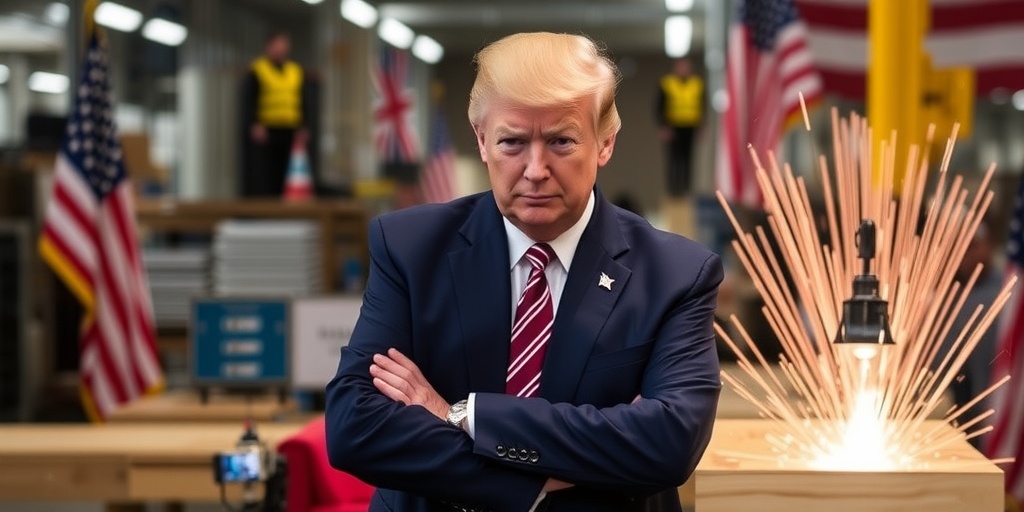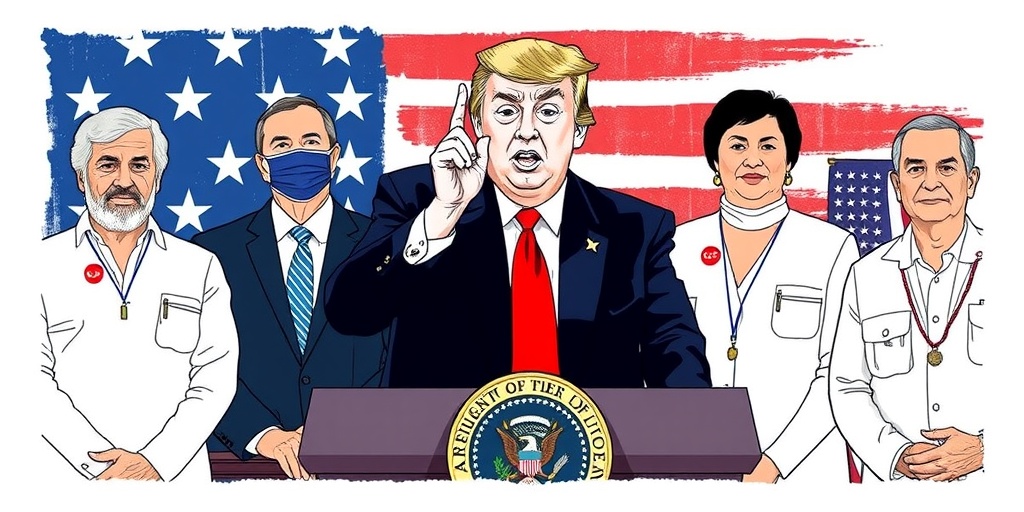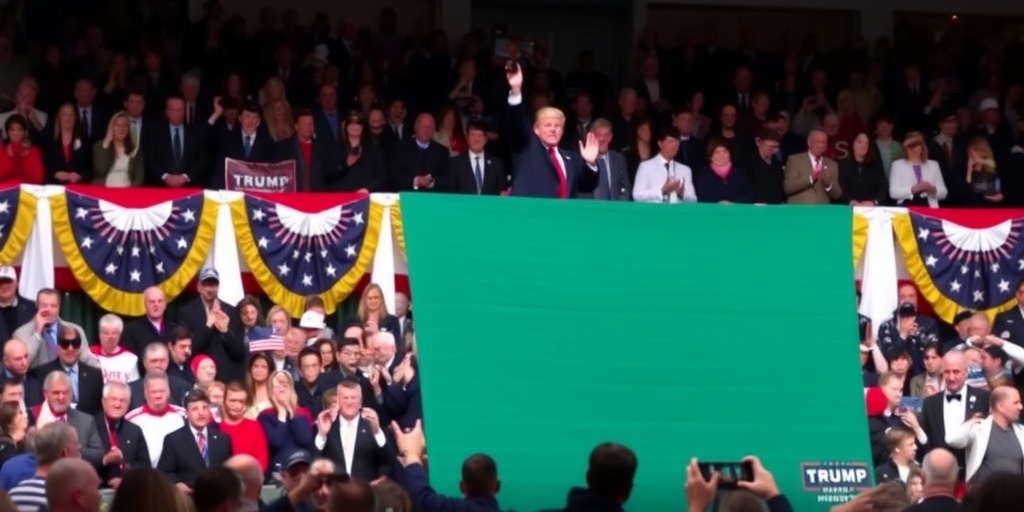Now Reading: Can Trump Tariffs Revitalize U.S. Manufacturing?
-
01
Can Trump Tariffs Revitalize U.S. Manufacturing?
Can Trump Tariffs Revitalize U.S. Manufacturing?

Title: Trump’s Tariff Strategy: A Bold Move to Restore American Manufacturing?
In a significant escalation of protectionist policies, President Trump has implemented tariffs on an unprecedented scale, marking a transformative moment in U.S. economic strategy. This move represents more than just a challenge to America’s international trading partners; it also embodies a nostalgic ambition to reclaim the nation’s historic stature as a manufacturing giant.
Historically, American manufacturing thrived after World War II, with nearly 20 million Americans employed in factories. The United States was a key player in the production of vehicles, aircraft, and steel, with manufacturing representing over a quarter of total employment. However, by the end of last year, the manufacturing sector had dwindled to employing only about 8 percent of the workforce, reflecting a dramatic shift in the U.S. economy that is now dominated by service-oriented jobs—both high-paying and low-wage.
As the economy grows wealthier, it presents a paradox where the industrial heartlands that once thrived have often deteriorated. Many of the regions that supported Trump’s political base now find themselves on the economic fringes amid the wider global reorganization of economic activity.
Protectionist sentiment has been gaining traction for the last decade, beginning in earnest with Trump’s first presidential campaign in 2015. His recent announcement of tariffs, delivered during a ceremonial event in the Rose Garden, signals a seismic shift away from the global free trade policies that received bipartisan support since the 1980s. “With today’s action, we are finally going to make America great again—greater than ever before,” Trump asserted, predicting a resurgence of American jobs and factories.
The administration also announced its intention to position the United States as a "Global Superpower in Manufacturing," crediting domestic investment by tech giants like Nvidia and automotive manufacturers as evidence of this strategic pivot.
Nevertheless, many economists and business leaders express skepticism regarding the efficacy of this tariff-driven campaign. They question whether these measures can effectively reverse the long-term decline in manufacturing employment—a trend exacerbated by various global factors and the increasing automation of factories.
While disagreements persist regarding Trump’s methods, there is a consensus among experts about the underlying issue: deindustrialization has inflicted lasting damage, largely overlooked for too long. A recent M.I.T. study highlighted the continued fallout from the sharp increase in imported Chinese goods, revealing that while some regions may have recovered from the initial impacts of this "China Shock," individual workers have not returned to stable employment.
The exodus of factory jobs over the last few decades has been driven by U.S.-based corporations seeking cheaper labor abroad to maximize profits while minimizing costs for consumers. Policymakers, worn down from conflicts with labor unions during high inflation periods, supported the transformation of globalizing firms in their shift toward offshore production.
In his effort to restore manufacturing, President Biden attempted a different approach, primarily focusing on empowering labor unions and endorsing subsidies for American manufacturing. However, with Trump’s recent victory and renewed tariffs, the landscape of industrial policy has shifted once again.
The current push not only aims to safeguard existing manufacturing jobs but to expand them, garnering unexpected support from some labor-oriented circles, including the United Auto Workers. Yet, critics warn that while these tariffs may encourage some production to return to the U.S., they will also drive up costs for manufacturers and consumers alike.
Some analysts have raised alarms about the long-term economic implications of these tariffs. There are concerns that imposing high tariffs on foreign goods can inadvertently hinder domestic manufacturers that rely on imported materials. Recession fears are on the rise, with many observers noting that success in boosting American manufacturing seems elusive amid the complexities of modern global trade.
Brad Setser, a senior fellow at the Council on Foreign Relations, advocates a more moderate approach to trade, emphasizing that while tariffs can serve as protective measures, they typically do not resolve trade deficits but instead reduce overall trade volume. Historical data shows that despite previous tariff initiatives during Trump’s first term, the U.S. trade deficit expanded significantly, reflecting ongoing challenges in the manufacturing sector.
Arthur Wheaton, a labor studies director at Cornell University, describes the current tariff situation as “disruptive but not completely insane.” He supports targeted tariffs but criticizes the erratic negotiation tactics of the Trump administration, which raise uncertainties for businesses.
Despite diverging opinions on the effectiveness of tariffs in revitalizing American manufacturing, some advocates believe that a robust tariff strategy could be beneficial. They argue for additional initiatives such as industrial policy investment and domestic production tax credits to incentivize companies to bolster their manufacturing capacities within the U.S.
As Trump embarks on this ambitious tariff journey, the future of American manufacturing hangs in the balance, clouded by uncertainties but filled with potential for a transformative industrial revival. The challenge now lies in navigating a complex global landscape and ensuring that these policies translate into meaningful job growth and economic stability.
Stay Informed With the Latest & Most Important News
Previous Post
Next Post
-
 01New technology breakthrough has everyone talking right now
01New technology breakthrough has everyone talking right now -
 02Unbelievable life hack everyone needs to try today
02Unbelievable life hack everyone needs to try today -
 03Fascinating discovery found buried deep beneath the ocean
03Fascinating discovery found buried deep beneath the ocean -
 04Man invents genius device that solves everyday problems
04Man invents genius device that solves everyday problems -
 05Shocking discovery that changes what we know forever
05Shocking discovery that changes what we know forever -
 06Internet goes wild over celebrity’s unexpected fashion choice
06Internet goes wild over celebrity’s unexpected fashion choice -
 07Rare animal sighting stuns scientists and wildlife lovers
07Rare animal sighting stuns scientists and wildlife lovers





















